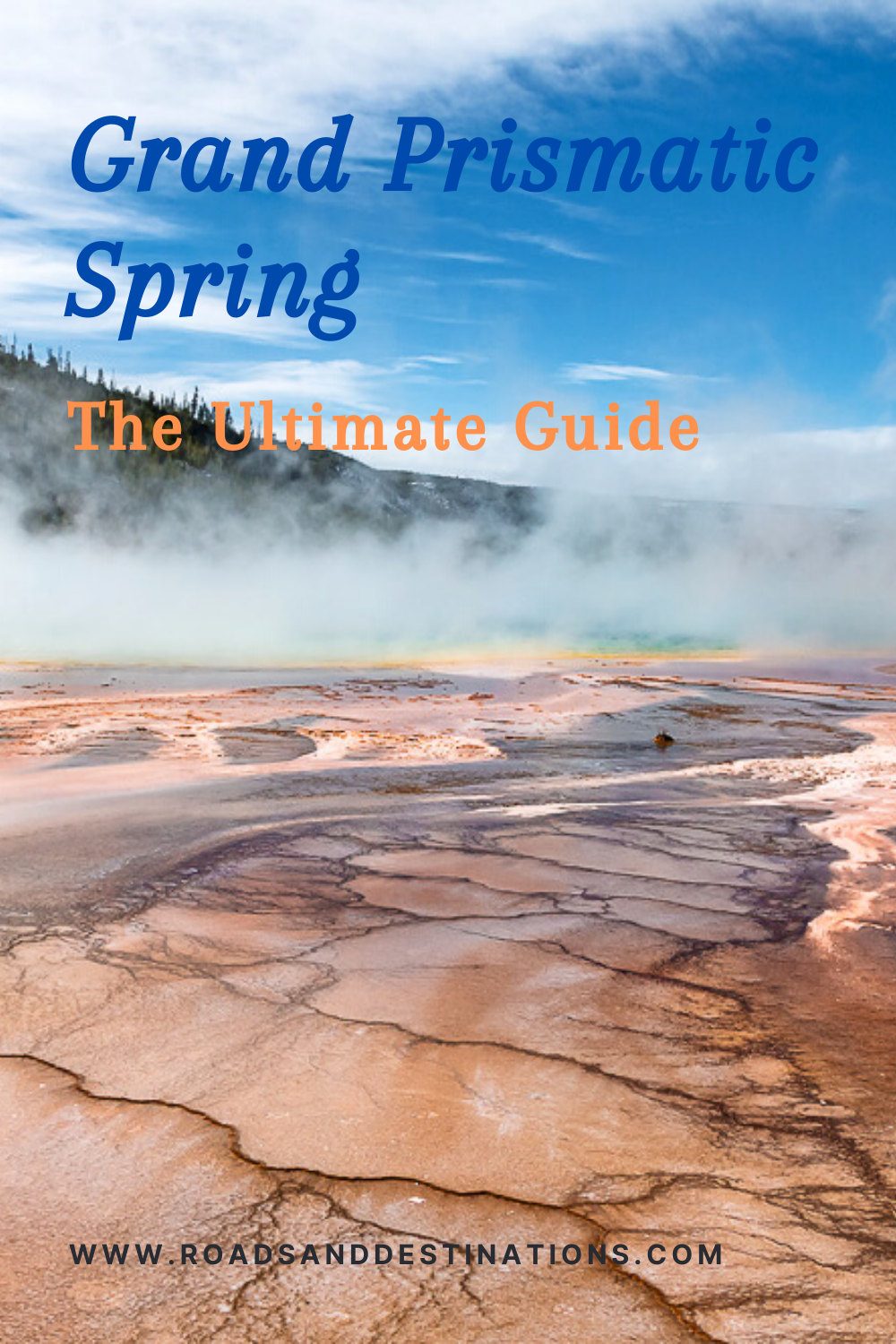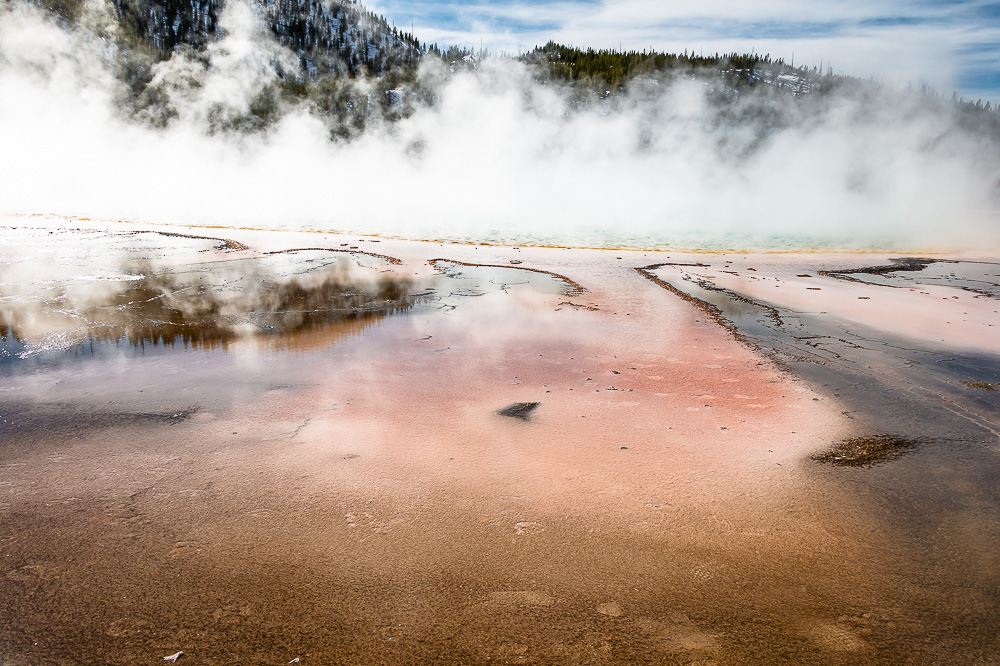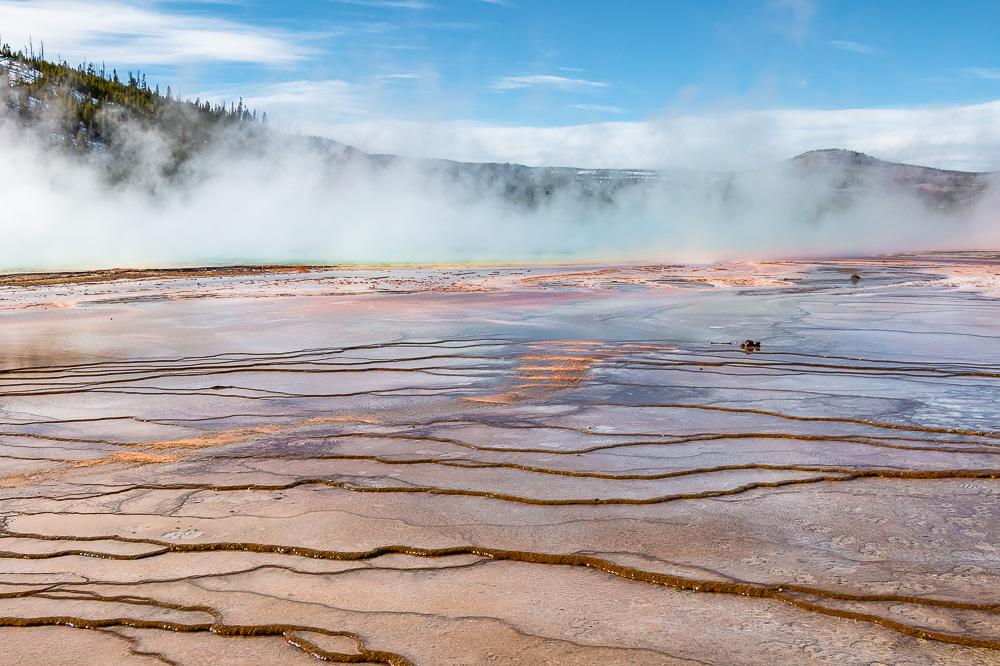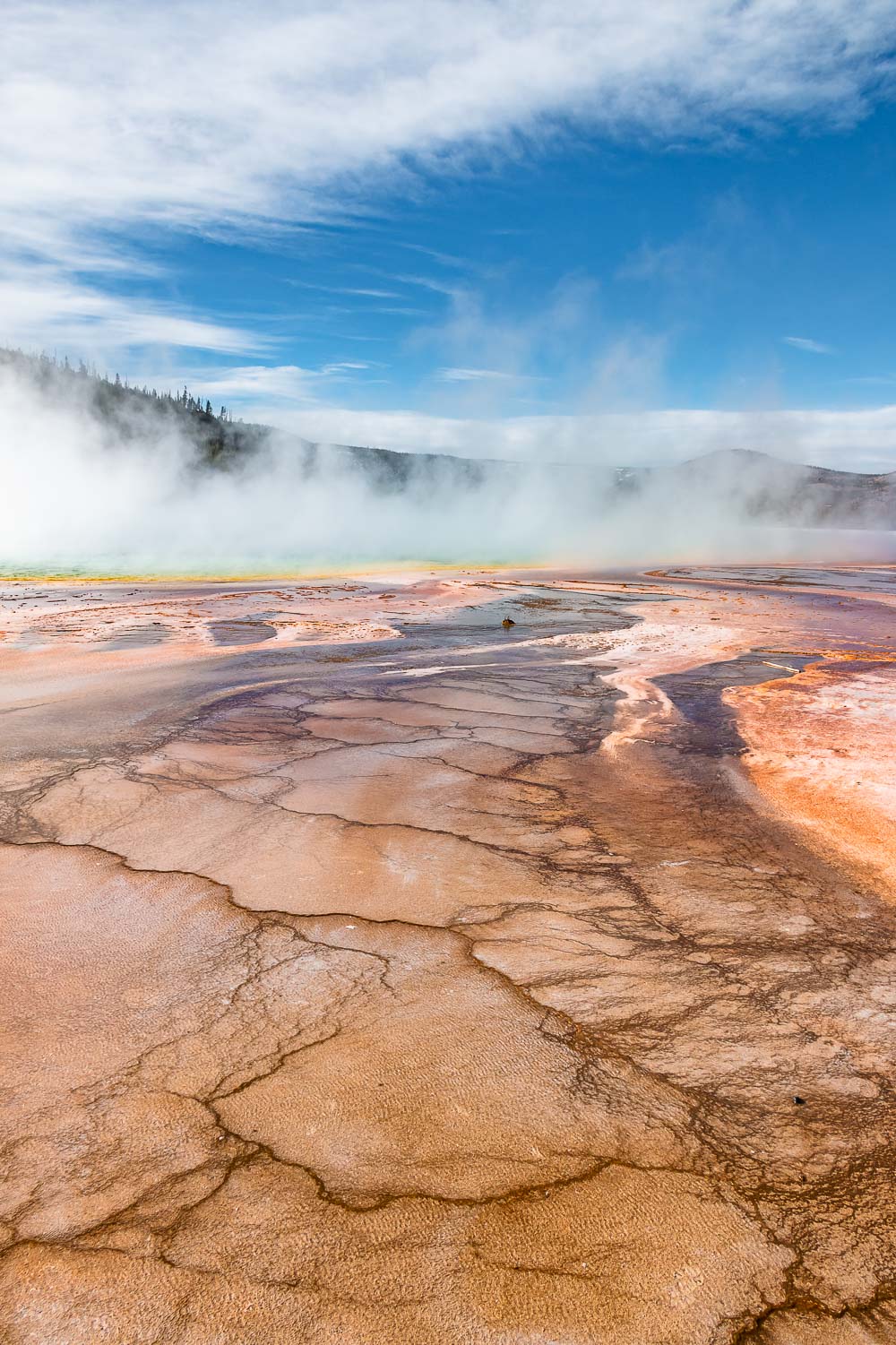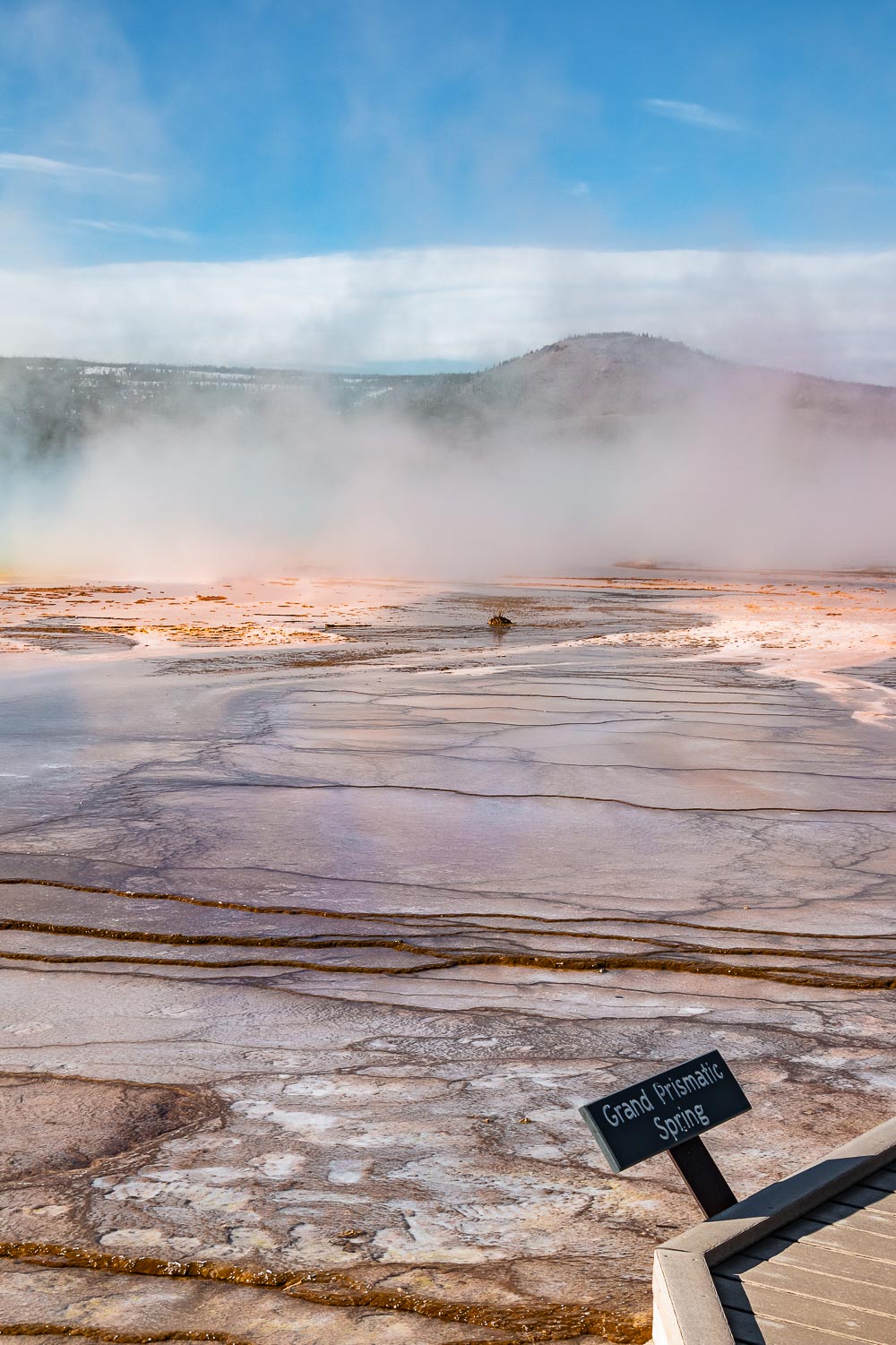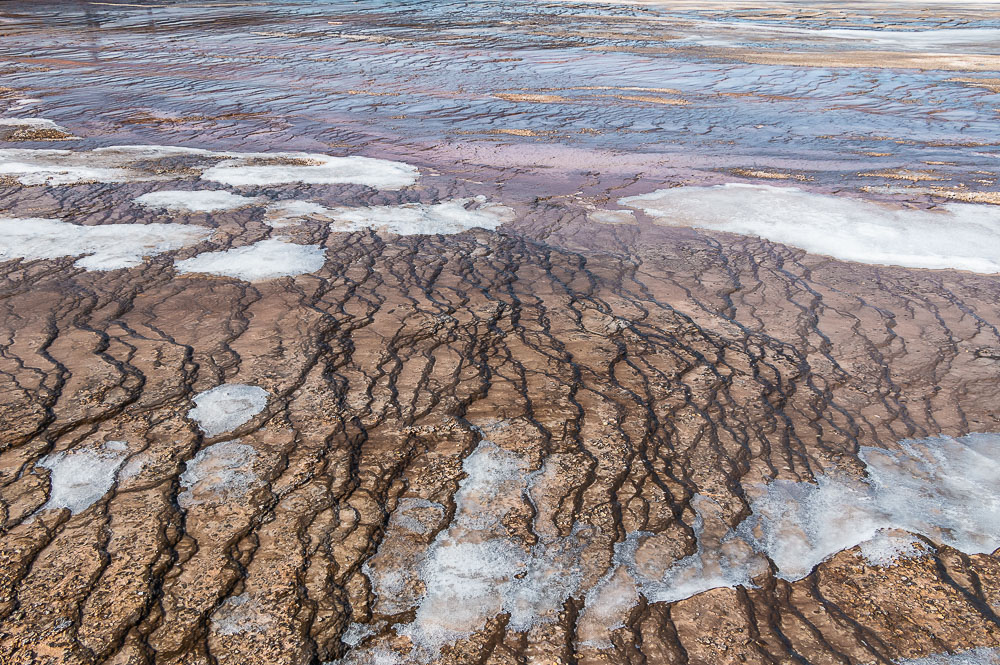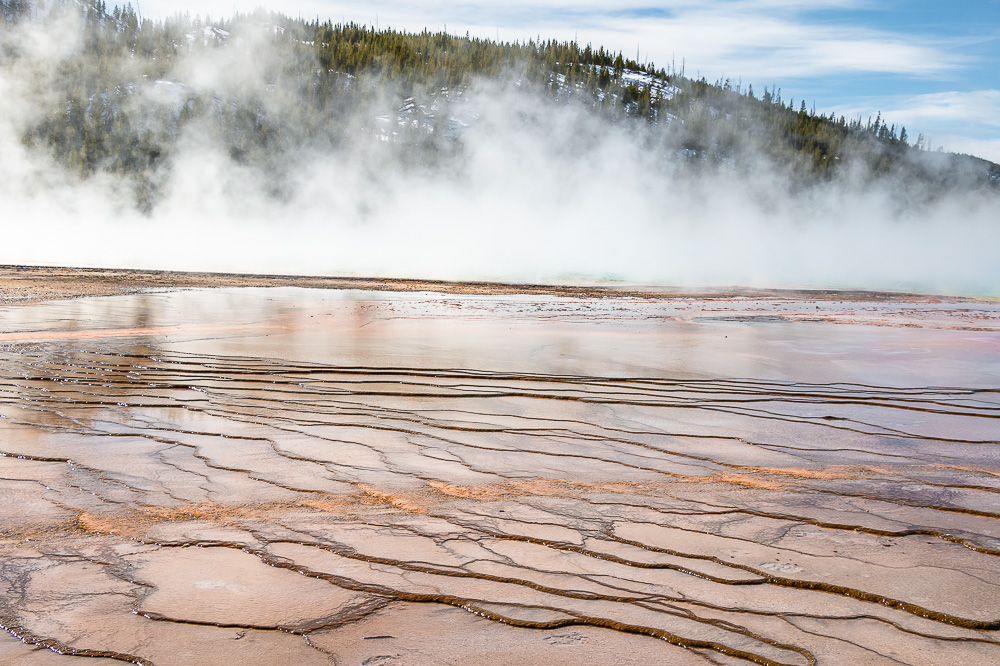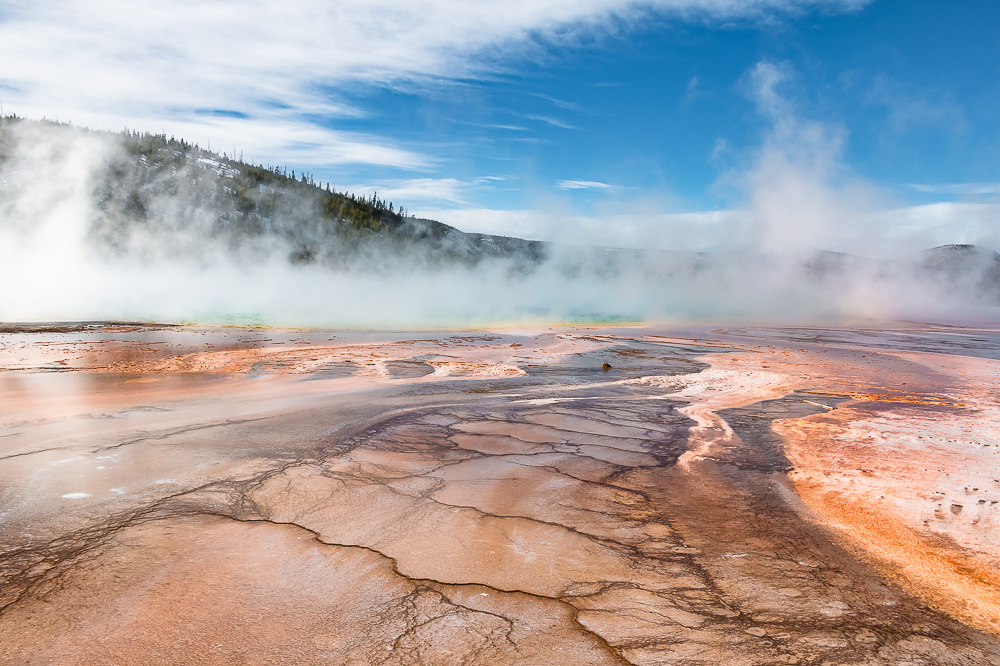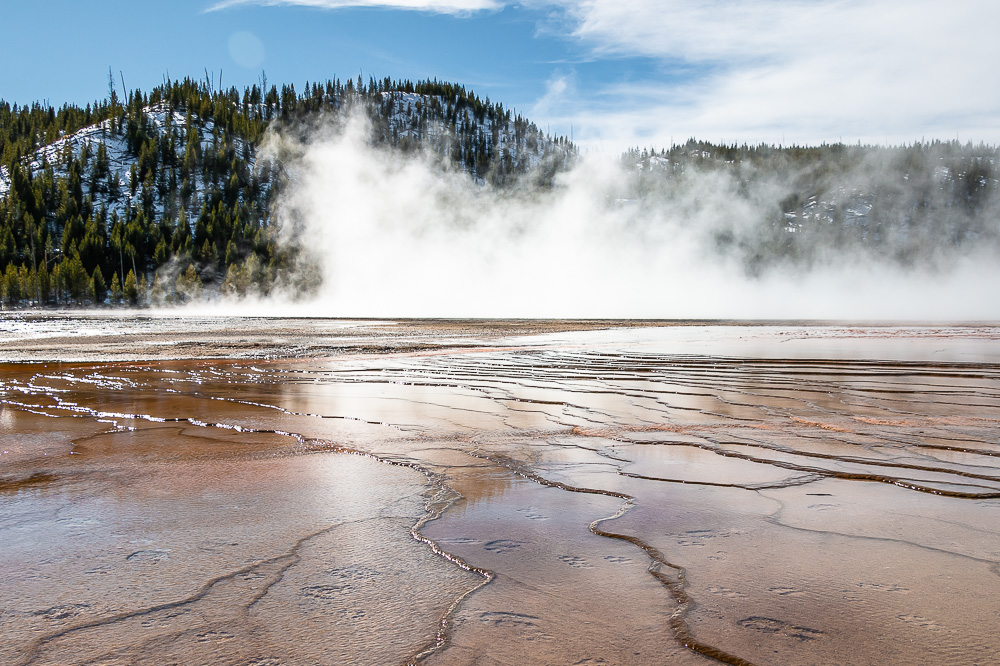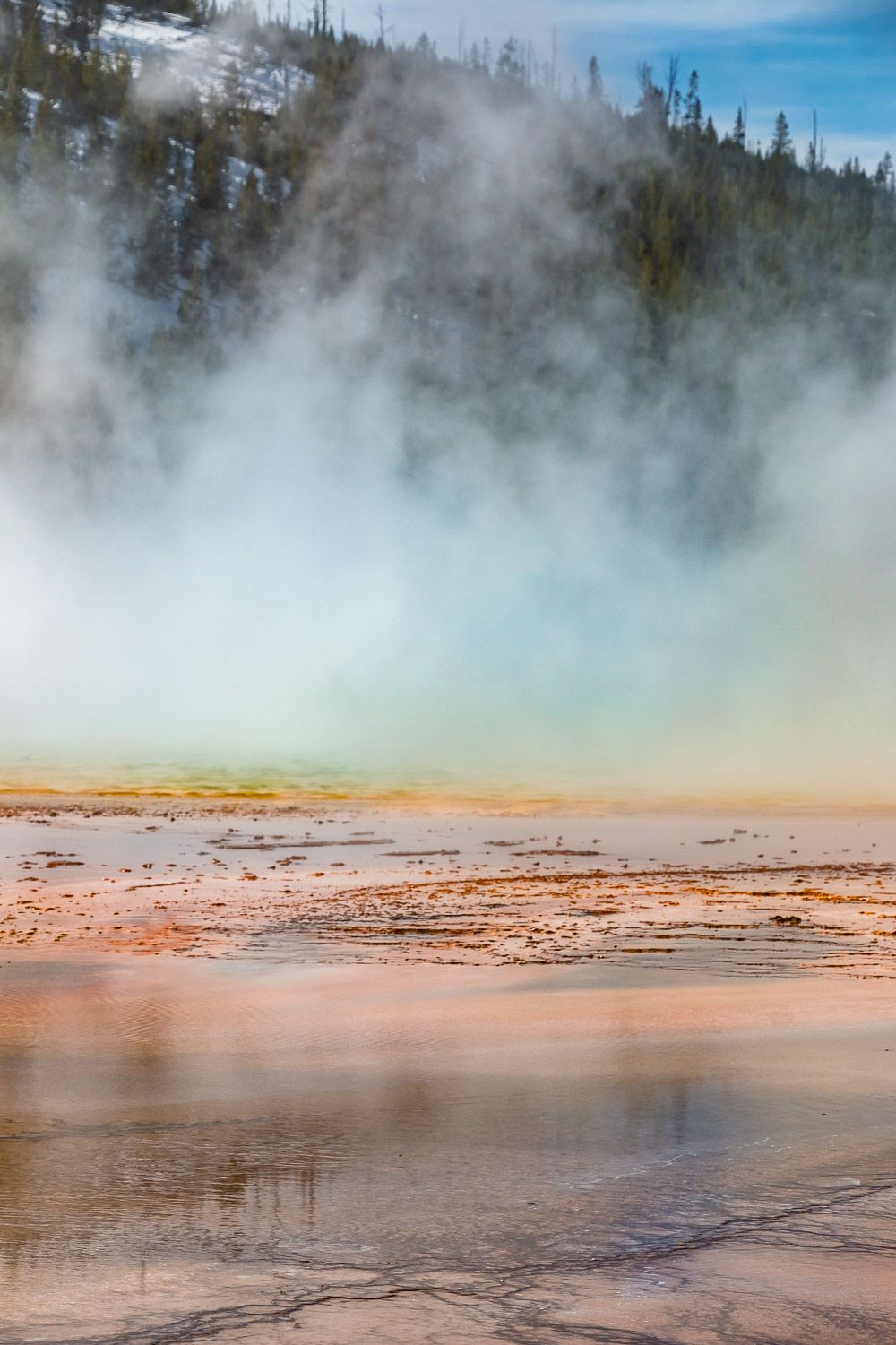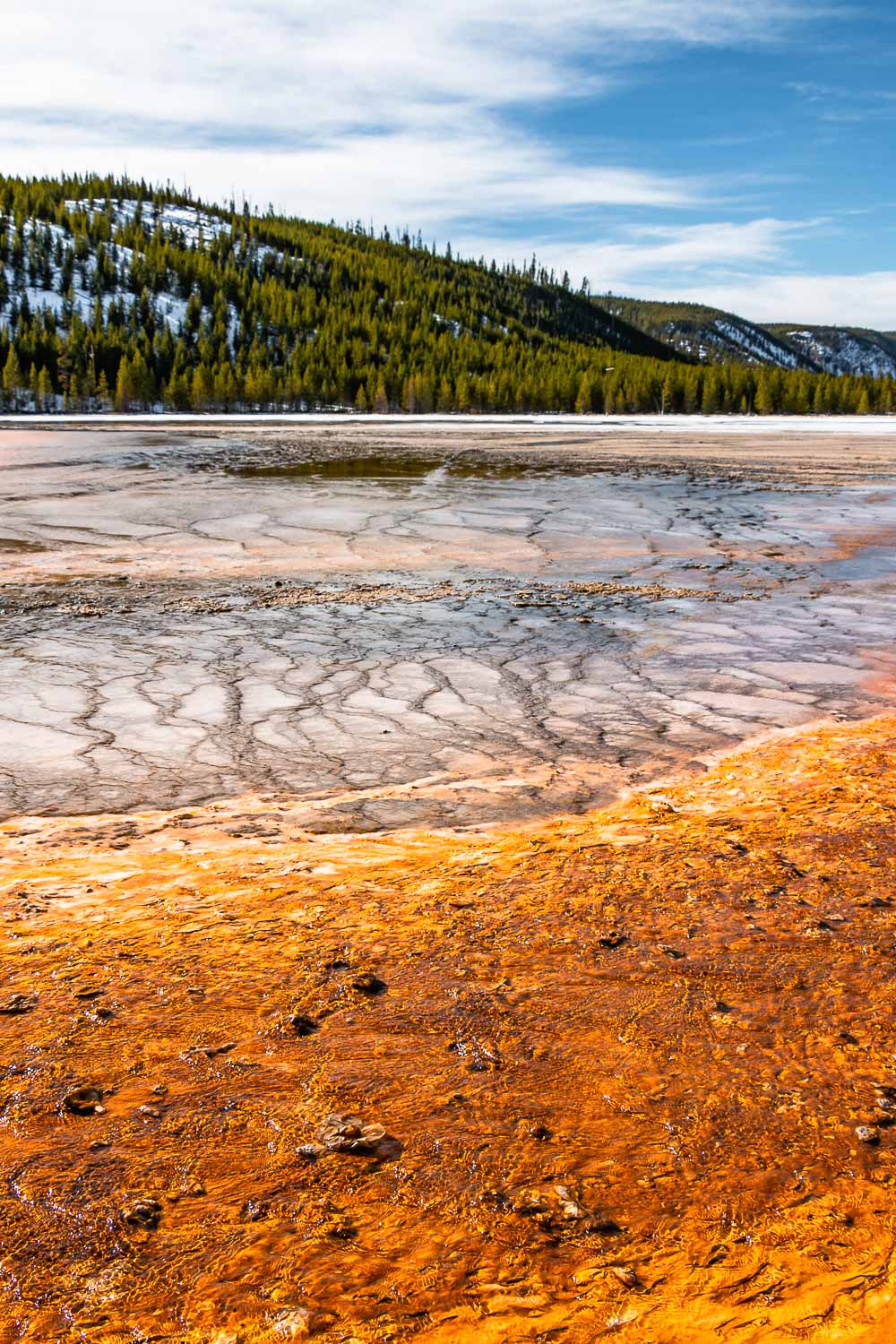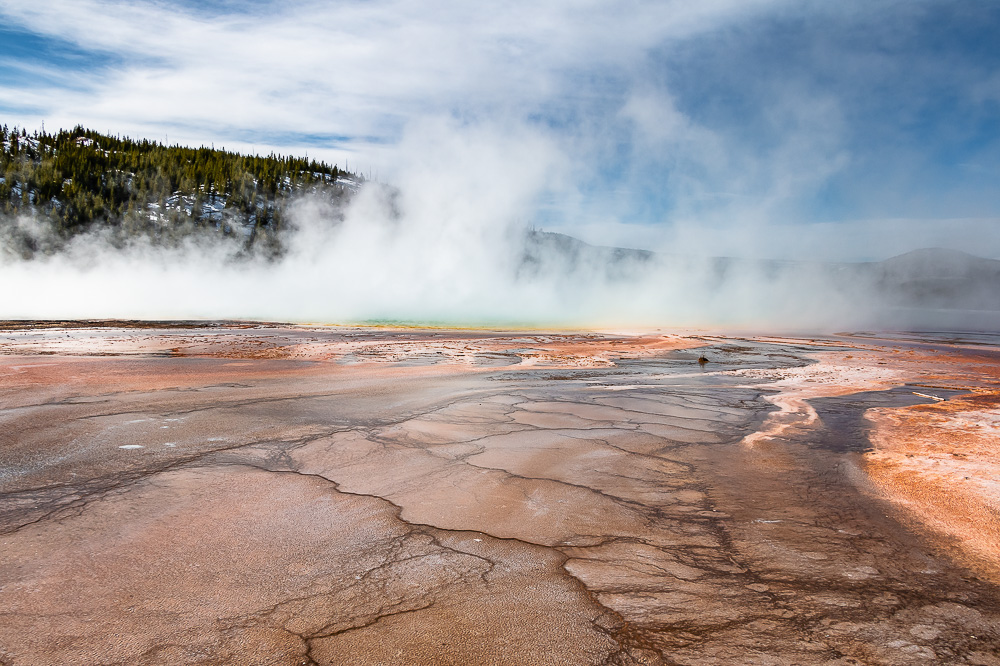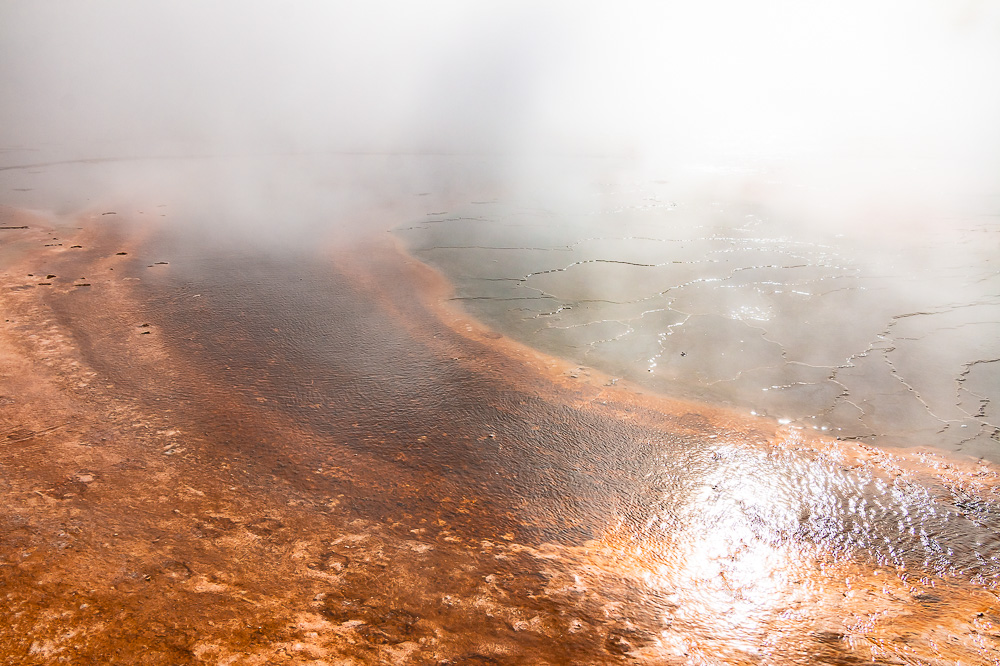The Grand Prismatic Spring or, like people often call it, “the eye” is one of the most remarkable places to visit in the Midway Geyser Basin in Yellowstone National Park. Ever-changing, vibrant, sparkling, gigantic… It’s not hard to see why this natural attraction enjoys such popularity and entices millions of visitors every year.
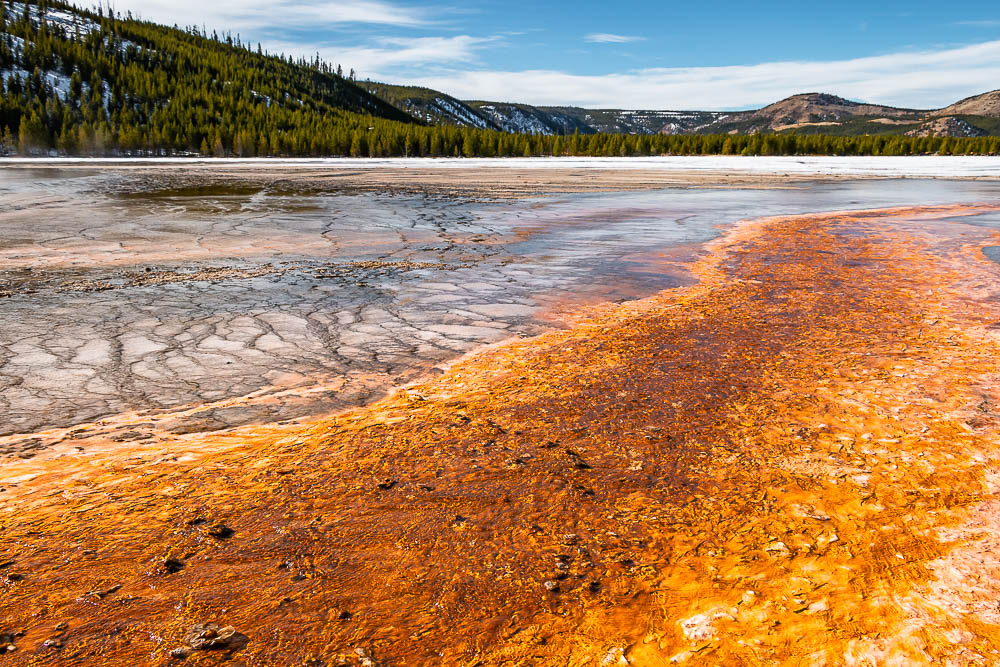
Crowds of tourists flock to the Grand Prismatic Spring to gaze at its colors and enjoy a round of thick steam “shower”. Such an unusual sauna feels oh, so welcome in the colder months. However, gusty winds blowing from the Firehole River and hot breath of the Grand Prismatic Springs from the opposite direction certainly disturb some oblivious visitors.
Standing on a boardwalk and taking these contrast “showers” unnerved me at first, as well. With no railings to hold on to, Yellowstone’s main attraction looked dangerous at the end of October. Nevertheless, I persevered to enjoy the stunning views without being swept into the colorful bubbling spring. Had it happened, it would be a completely different story of our first visit to the Grand Prismatic Spring in Yellowstone National Park. But jokes aside.
The question remains, though. Are the Grand Prismatic Spring and the Midway Geyser Basin worth a visit? Absolutely.
In this Visit Grand Prismatic Spring guide, we’ll go into details of what to do and see in the Midway Geyser Basin and answer the most frequently asked questions. What makes the Grand Prismatic Spring so colorful? How to get to the Grand Prismatic Spring? What is the best time to visit the Grand Prismatic Spring? Can you visit the Grand Prismatic Spring in winter? How to photograph the Grand Prismatic Spring?
Continue reading to find the answers to all of these and many other questions and get inspired for your own visit to the Grand Prismatic Spring.
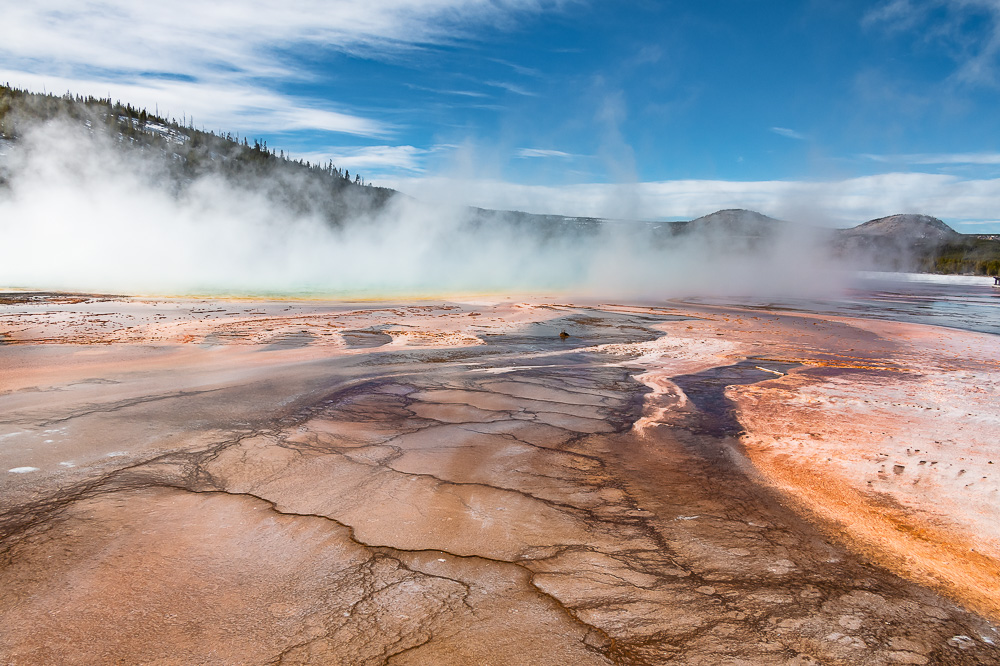
Visit Grand Prismatic Spring: First Impression
The Grand Prismatic Spring is indeed one of the most remarkable features to visit in Yellowstone National Park. The vibrant pool enjoys fame as the largest hot spring in the United States and the third largest in the world. Only Frying Pan Lake in New Zealand and Boiling Lake in Dominica dare to surpass the Grand Prismatic Spring, Yellowstone’s crowned jewel and the highlight of every visit.
The famous hydrothermal feature is located in the Midway Geyser Basin. The largest resident of the area, the Grand Prismatic Spring is an undeniable show stealer whether you enter Yellowstone from the South, East, West, North, or Northeast Entrance.
Even the Internet falls prey to the astounding spring. Those who visit Yellowstone for the first time and browse the web to plan their itineraries are surprised to find pictures of the Grand Prismatic Spring more often than any other landmarks of the park. It makes sense. The Grand Prismatic Spring is the most photographed hydrothermal feature in Yellowstone, after all.
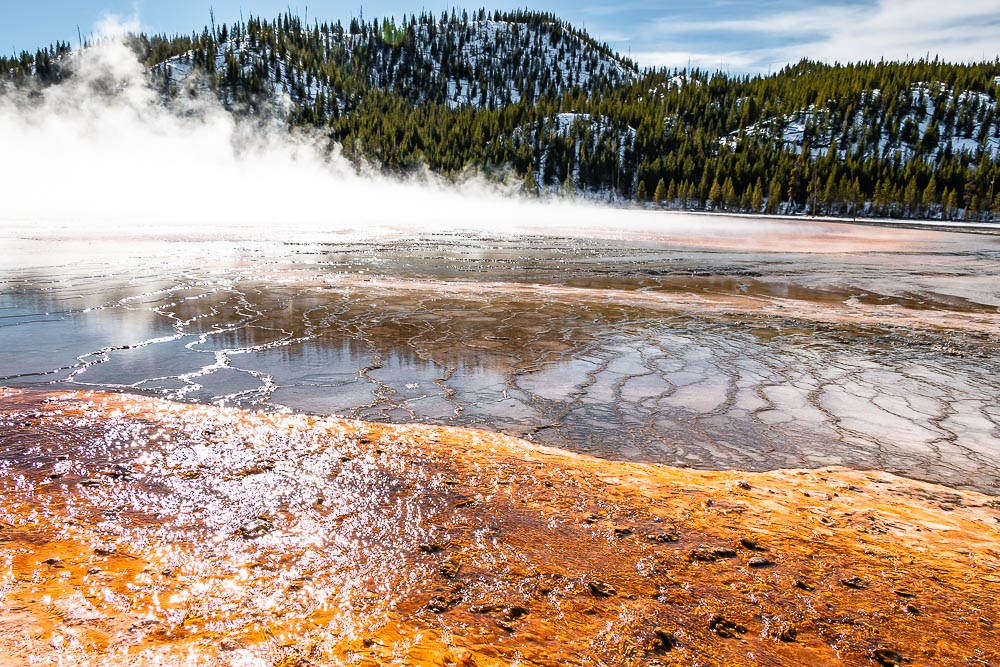
The Best Time to Visit Grand Prismatic Spring in Yellowstone National Park
Visit Yellowstone in Winter: November – March
Yet, you can hardly find any pictures of the vibrant spring in winter. Apparently, not many people visit the Grand Prismatic Spring and Yellowstone National Park during the colder season. There is certainly a reason behind it.
The national park in the northwest corner of Wyoming is a rather seasonal attraction. Most of its roads take a winter break and ask the visitors of the Grand Prismatic Spring and other popular attractions in Yellowstone to do the same. Heavy snowfalls cover the park’s routes from November until March. Subzero temperatures also don’t inspire the majority of nature enthusiasts to visit the iconic Grand Prismatic Spring at this time of the year. Considering the remote location of Yellowstone National Park, such harsh winter conditions mean only one thing: winter road closure across the entire park.
Nevertheless, you can still visit some parts of Yellowstone, including the Midway Geyser Basin with its iconic Grand Prismatic Spring, during this season. The park’s roads reopen for the winter session in mid-December and stay open until early March. But here’s the catch. No private vehicles can enter the area. Only oversnow travel (guided snowmobiles or snowcoaches) are allowed in Yellowstone in winter.
If you still dream of a visit to the Grand Prismatic Spring during the colder season, considered looking into winter tours.
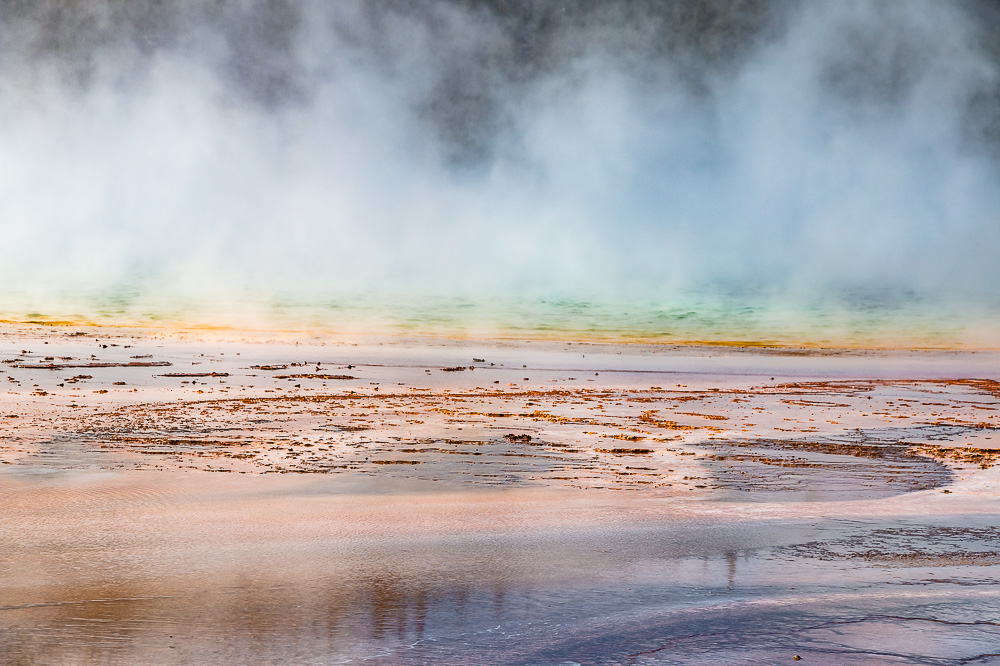
Visit Grand Prismatic Spring in Spring and Summer
The roads to the popular destinations in Yellowstone National Park start reopening to the public in mid-April. Be sure to check the National Park Service’s website for all road updates and opening days before visiting the area, though.
During this time, Yellowstone, including its famous Midway Geyser Basin and the Grand Prismatic Spring, are still resistant to major disturbances caused by large crowds that visit the area in summer. The days are cold, and the winds are still strong enough to prevent you from spending most of the time outside. Yet, Yellowstone gets friendlier and friendlier day by day.
With the arrival of the warmer weather, more tourists visit Yellowstone National Park and inevitably stop at the Grand Prismatic Spring. The most popular time to visit the Midway Geyser Basin is between May and September when all of the park’s roads are open. Such convenience, however, has its own disadvantages. Significantly more people visit the Grand Prismatic Spring during the spring-summer season. The area is especially busy around noon when tour buses flock to the Midway Geyser Basin.
July and August are the busiest months of them all. Families with kids who are out of school by then visit the Grand Prismatic Spring and take their time admiring the rainbow colors of the spring and hiking in the area nearby.
TIP: Visit the Grand Prismatic Spring in Summer to See Colorful “Rings” at Their Peak
Speaking about the vibrant colors of the Grand Prismatic Spring, a summer visit rewards you with the brightest hues. Bacterial mats around the spring intensify their signature yellows and orange hues. Blue water of the Grand Prismatic Spring looks even more profound – a sure thing that you chose the right time to visit the Midway Geyser Basin.
Visit Grand Prismatic Spring in Shoulder Months
However, after our visit to the Grand Prismatic Spring in October, just a couple of days before the winter road closure, I can’t imagine sharing the relatively small Midway Geyser Basin with the endless crowds. Moreover, do you really want to wait for a parking spot before you can walk up the hill and feast your eyes on the Grand Prismatic Spring? I thought so.
Therefore, I’d recommend that you visit the Grand Prismatic Spring and, for that reason, any other hydrothermal features in Yellowstone during the shoulder seasons. Typically, it’s from April until May and between September and October. The weather is still mild, and fewer tourists visit the Midway Geyser Basin and the Grand Prismatic Spring at this time.
On cooler days, clouds of steam form over the spring. At the time of our visit, heavy vapor periodically covered the whole view. We had to wait for the wind to blow the steam away, so we could see the rainbow brilliance of the spring.
The colors are dimmer in the colder months. Yet, they are bright enough to appreciate the natural beauty of Yellowstone National Park. Sacrificing a certain degree of the color vibrancy is definitely a great trade-off for a chance to visit the Grand Prismatic Springs without the maddening crowds.
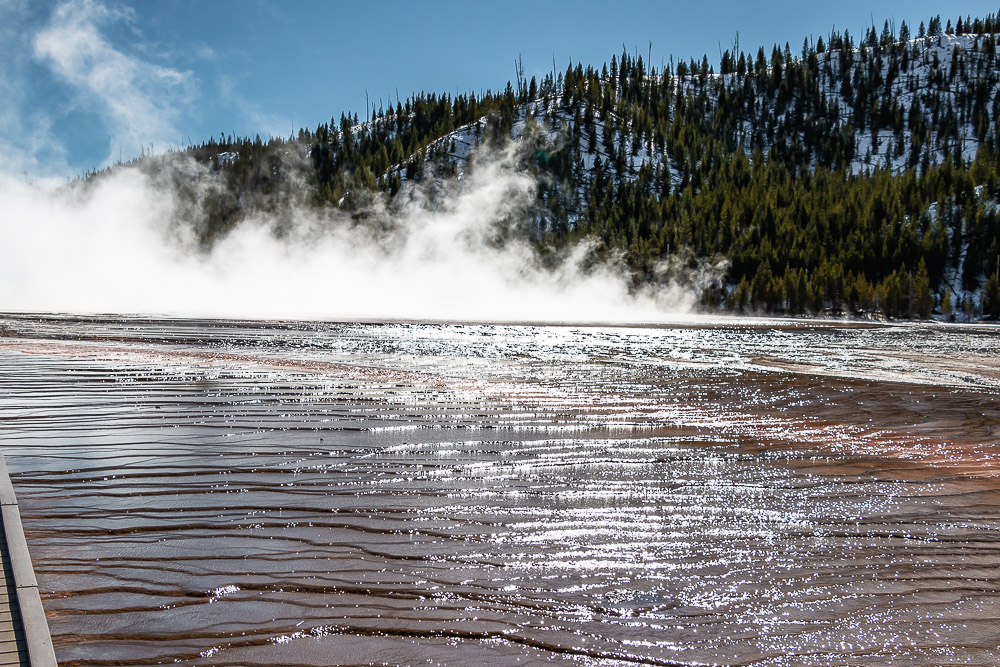
Location and How to Get to Grand Prismatic Spring
The Grand Prismatic Spring is the largest hot spring in the small, but astounding Midway Geyser Basin. Home to a few other big hydrothermal features, the basin is set a short drive north from the Old Faithful area in the Upper Geyser Basin. Those who start their adventures in Yellowstone from the North or West Entrances should head to the Madison Junction. From there, venture south toward the Old Faithful area. The road to the Grand Prismatic parking lot is clearly marked. You won’t miss it regardless of the direction you are traveling from.
The Grand Prismatic Springs sits a short walk uphill surrounded by a boardwalk to ensure a safe and unforgettable visit. The wooden man-made path starts from the parking lot, runs across the Firehole River, and snakes through the Midway Geyser Basin. During the summer season, you can also visit picnic area, located 1/4 mile north of the Grand Prismatic Spring.
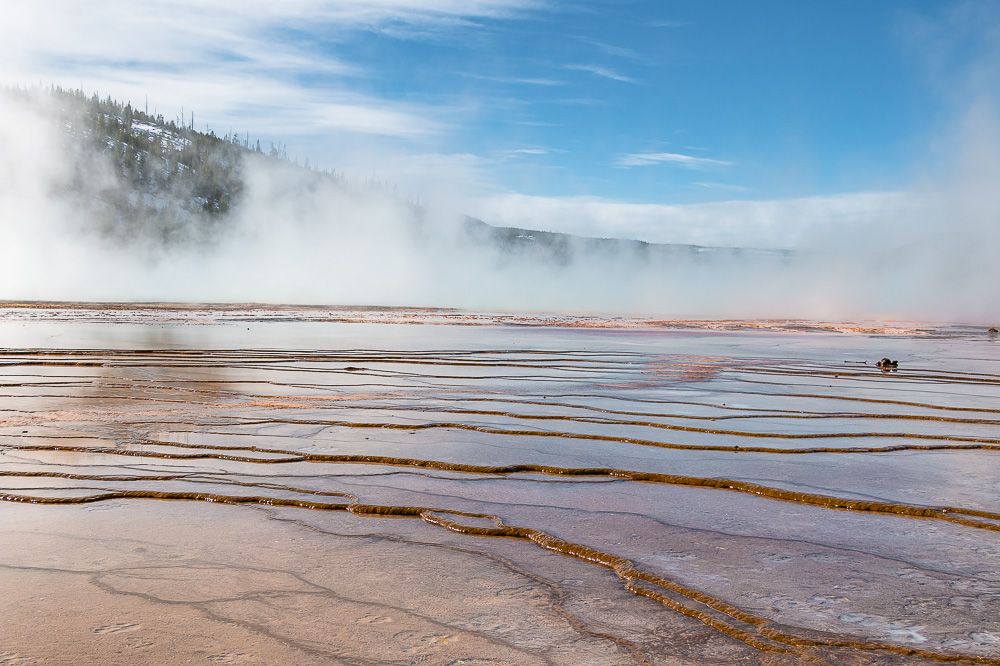
How to Visit Grand Prismatic Spring
Visit By Car
The Grand Prismatic Spring is best to visit when you are not restrained by time or need to share the boardwalk with a huge crowd. I surely enjoyed strolling near the spring at my own pace without feeling obligated to get back to the parking lot at a certain time.
TIP: Driving to Yellowstone National Park is a preferable way to experience it as many of its features spread across the vast area. Tour buses visit only the most popular natural landmarks such as the Grand Prismatic Spring and Old Faithful.
The open roads during the summer season allow the private vehicles to visit the Grand Prismatic Spring any time of the day. Ample maps and visitor centers along with offline google map also ensure that you get to your destination safely and in a timely manner. Even if you get lost for a while, it only gives you a chance to explore different parts of Yellowstone.
However, the biggest advantage of exposing the hydrothermal features in the Midway Geyser Basin on your own is time. You should plan your visit to the Grand Prismatic Spring early or late in the day to avoid the crowds. Tour groups frequent the area from approximately noon until 6 p.m. It surely gets way too busy to enjoy your visit and photograph the Grand Prismatic Spring during these hours.
Visit on a Tour
Despite the obvious advantages of arriving by car, a visit to the Grand Prismatic Spring with a guided tour has its own benefits.
First, you don’t need to worry about renting a car or preparing an itinerary. This is especially helpful for the tourists from other countries who don’t feel comfortable driving in the United States. (I joined a few guided tours in Ireland and certainly felt more at peace and relaxed than if I had to drive myself there.)
Second, winter guided tours let you visit some of the famous hydrothermal “dwellers” of Yellowstone National Park when the private vehicles can’t enter the park. The tours usually run from Jackson Hole, Teton Village, Cody, Gardiner, Big Sky, or Bozeman and take you to some of the popular attractions in the park. If you decide to visit the Grand Prismatic Spring with a guide, here are a few suggestions you can use to plan your trip.
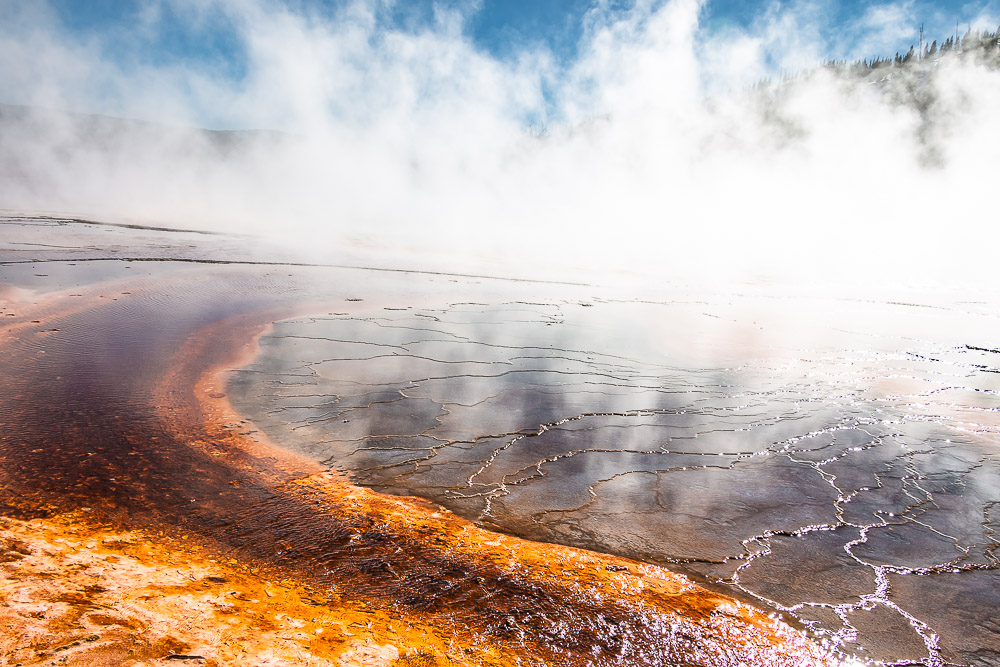
How Much Time Do You Need to Visit Grand Prismatic Spring
Less than an hour is enough time to see the colorful spring and its closest neighbors in the Midway Geyser Basin. The boardwalk loops around the area, allowing to admire, smell (can be bad), and photograph the natural wonders up-close. If you plan to visit the basin and get a bird’s eye view from Grand Prismatic Spring Overlook, consider spending 1-2 hours in this part of Yellowstone.
Visit Grand Prismatic Spring
Unlike other hydrothermal areas of Yellowstone National Park that brim with the hot springs and geysers, the Midway Geyser Basin has only a handful of big features. The Grand Prismatic Springs is the largest of them. In most cases, it’s the only reason to visit the smallest basin in Yellowstone in the first place.
The other colorful residents of the Midway Geyser Basin such as Excelsior Geyser Crater, Opal Pool, and Turquoise Pool come as an unexpected, but always pleasant surprise. We have a separate blog post devoted to the Midway Geyser Basin and its lesser-known hydrothermal features. As for now, learn more about the remarkable Grand Prismatic Spring to be fully prepared for your future visit.
LEARN MORE: Visit Midway Geyser Basin (Beyond Grand Prismatic)
Grand Prismatic Spring
The Grand Prismatic Springs is the largest dweller of the Midway Geyser Basin. Every visit to this area inevitably starts and ends with gazing at this gigantic, colorful “lake”. If the vibrant colors allure in the first place, the steam – big enough to hide the whole view – is another reason to admire this natural phenomena.
While planning your trip, you surely come across hundreds of stunning pictures of this natural wonder. Captivating you from your computer screen, these images inspired you to visit the majestic Grand Prismatic Spring as soon as possible. However, the colorful giant looks different when you stand next to it.
At 360 feet wide and 160 feet long, it’s bigger than you’ve ever imagined. Normally, the Grand Prismatic Springs enhances your visit with a view of a small part of its enormous body, unless you decide to climb uphill. Looking at famous colorful layers up-close also feels surreal as if somebody purposely painted them to impress you.
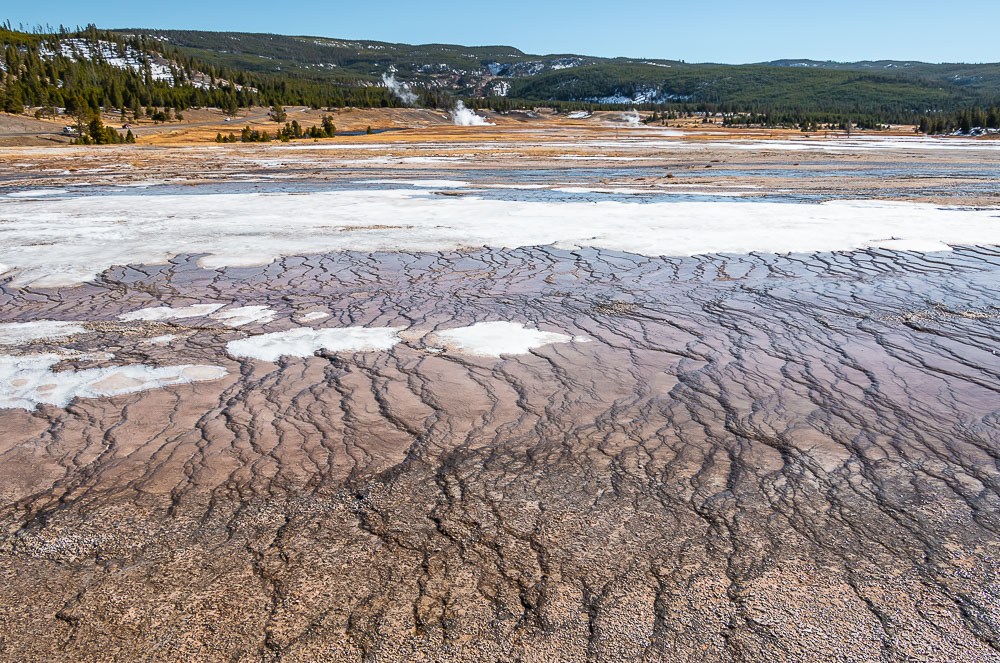
Visit Grand Prismatic Spring: A Word from History
No wonder, the Midway Geyser Basin’s finest resident owes its name to its rainbow colors. The vibrant coloration amused the Hayden Expedition visited the area in 1871 to such an extent that they agreed on called the hot pool the Grand Prismatic Spring.
Interestingly enough, artist Thomas Moran who traveled with the expedition made watercolor sketches of the spring. When people who didn’t see the Grand Prismatic Spring in person, glimpsed at those images, they couldn’t believe their eyes. The bubbling lake looked too vibrant to be true. Thus, in 1878, geologist A.C. Peale returned to verify the colors. The Grand Prismatic Spring, certainly, didn’t fail to impress neither the geologist nor other people who went to visit the basin afterward.
This brings us back to the size of the gigantic spring. How can you take these stunning images and enjoy the view of the famous hydrothermal feature? This is why you decided to visit the colorful Grand Prismatic Spring in the Midway Geyser Basin in the first place, isn’t it? The answer is simply. You need to gain the elevation. I’ll get back to this part of your visit to the Grand Prismatic Spring a little bit later.
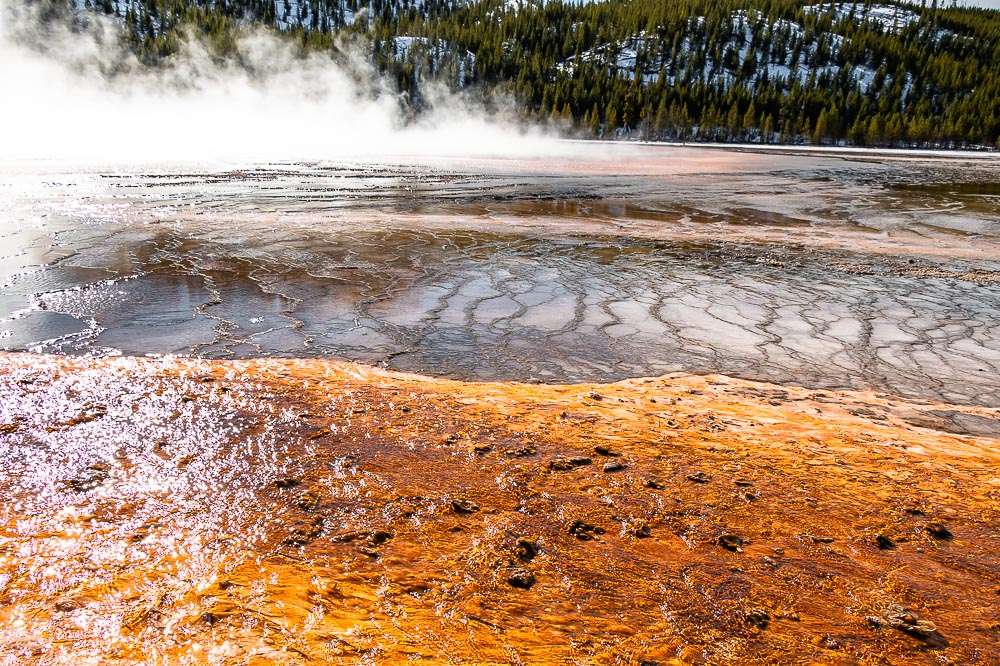
Secret Behind Grand Prismatic Spring’s Vibrant Colors
Even though every hydrothermal features in the Midway Geyser Basin impresses with their bright coloration, the Grand Prismatic Spring always steals the show and is the main reason to visit the area. The spring is famous for its vibrant layers of orange, yellow, and green colors surrounding the deep blue water at the center. The oblivious visitors assume that this colorful vibrance is a side effect of the thermal activity underneath the surface. Those who visit the Grand Prismatic Spring for the second or third time know it better.
Different species of thermophile (heat-loving bacteria) are responsible for the rainbow shades of the spring. A large number of the bacteria clusters in the colder water around the Grand Prismatic Spring, forming the multiple colorful rings, known as the bacterial mats.
The color saturation depends on the amount of chlorophyll to carotenoids (pigments of different colors). They vary based on the water temperature, which plays a huge role in settlement of the bacteria responsible for the different hues of the Grand Prismatic Spring. In summer, when the water temperatures are higher, the bacterial mats tend to be orange and red while in winter they fade and turn green.
The hot temperatures at the center of the Grand Prismatic Spring create an unbearable environment even for the heat-loving bacteria. Unable to accommodate any living organisms, this part of the spring keeps its deep blue color throughout the year.
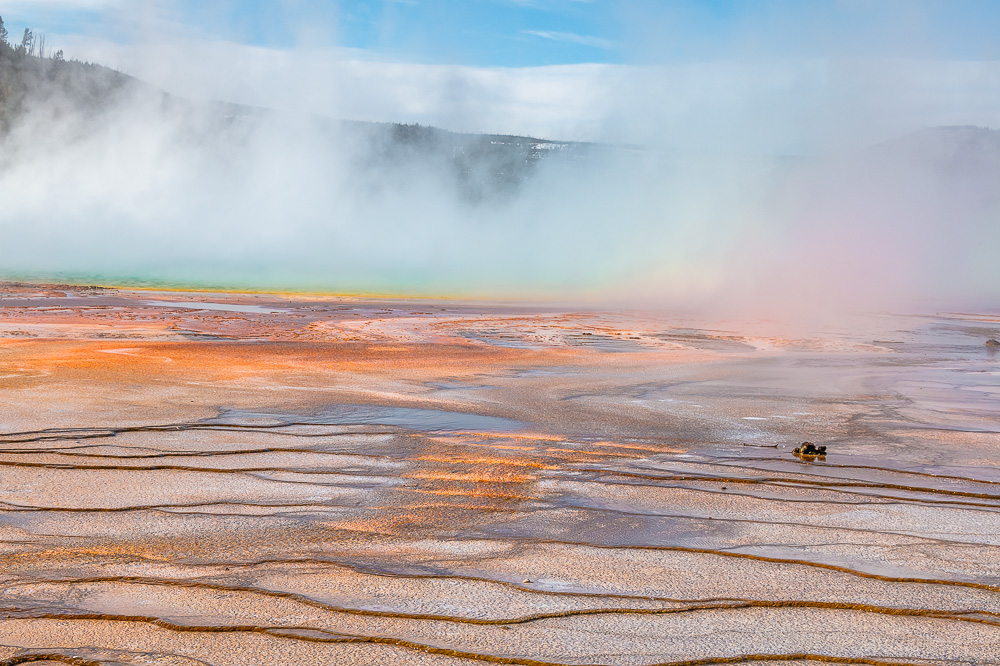
How to Visit and See Grand Prismatic Spring
The number of things to do when visiting the Grand Prismatic Spring is rather limited. No swimming, no walking off the boardwalk to get a better look at the hydrothermal features… Yellowstone’s wildlife also hardly joins you in the Midway Geyser Basin. And yet, a visit to the Grand Prismatic Spring tops the majority of Yellowstone National Park’s itineraries. Gazing at the natural wonder up-close it the biggest reward itself. Luckily, you can enjoy the Grand Prismatic Spring from both near and far.
Admire Grand Prismatic Spring from Boardwalk
The one-way boardwalk snakes around the Midway Geyser Basin, allowing to see the Grand Prismatic Spring up-close. It’s also the best way to “shower” in the warm steam coming from the hydrothermal feature.
However, being extremely convenient, the boardwalk gets busy during the day and especially in summer. So, if you want to spend more time admiring and photographing the bright rainbow rings without the crowds, be sure to arrive early in the morning or late in evening.
During our visit in late October, the Grand Prismatic Spring never looked busy even at noon. We spent plenty of time on the boardwalk, enjoying and photographing the Grand Prismatic Spring. The best part, only a few people passed by without disturbing neither us nor themselves.
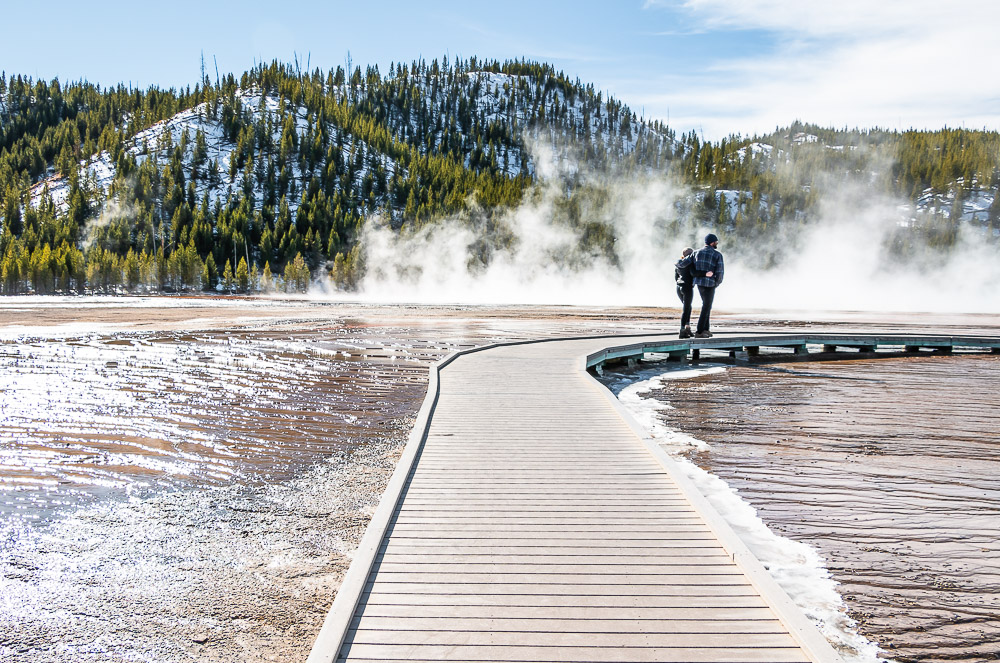
Tips for Experiencing Grand Prismatic Spring from Boardwalk
The boardwalk loops around the Midway Geyser Basin, enabling even people with disability to take in the view of the Grand Prismatic Spring up-close. There is no railings, though. Thus, be sure to offer support to elderly people and children who visit the Grand Prismatic Spring with you.
Furthermore, the Midway Geyser Basin experiences strong winds, especially during the winter season. Therefore, it’s recommended to hold on to your hats, caps, and anything that the gusty winds can easily blow away. Retrieving your personal items from the spring is impossible. Moreover, any foreign objects destroy the heat-loving bacteria and interfere with the fragile environment of the Midway Geyser Basin.
Hike to Grand Prismatic Overlook
Finally, after admiring the Grand Prismatic Spring up-close, you can see how it looks like from above. For this reason, you need to hike uphill to Grand Prismatic Overlook. A scenic viewpoint is the newest addition to the area. The official viewing point adorned the hill overlooking the spring in July 2017, although it was first proposed back in 1997.
Until the establishment of the new overlook, the visitors used an unofficial trail to gain the elevation and admire the Grand Prismatic Spring from above. It wasn’t safe. Never maintained, this path presented its share amount of challenges and even saw a fatal accident. In 2014, under windy conditions, a lodgepole pine tree fell on a man and killed him.
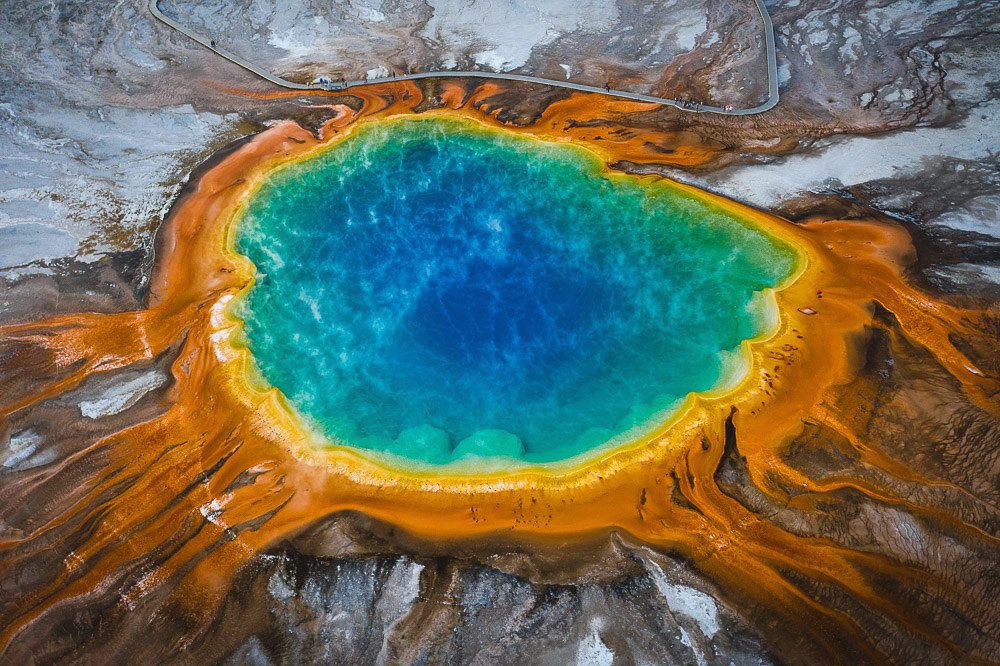
Grand Prismatic Overlook Trail
With the official Grand Prismatic Overlook Trail, most of the visitors have a change to admire the thermal feature from above. The trail to the viewing point follows the Fairy Fall Trail for 0.6 miles until they separate and each goes in its own direction. From the fork, you need to climb another 105 feet to reach the vantage point.
The 1.2-mile round-trip trail opens in late May and gives you a change to gauge the full size of the Grand Prismatic Spring until late fall. The trailhead starts at the Fairy Falls parking lot, one mile south of the Midway Geyser Basin. From there, cross the bridge across the Firehole River. A modest sign marks the start of the trail. Getting lost while attempting to see the Grand Prismatic Spring from above, however, equals to zero. You can alway follow other tourists heading to the overlook.
The trail is rather wide at the bottom and narrows as you climb higher. It becomes steep and slippery near the top, making the hike challenging. People with disabilities might just want to skip this activity during their visit to the Grand Prismatic Spring altogether. Those who make to the top find a beautiful spot with the panoramic view of the Grand Prismatic Spring.
The hike takes approximately 30 to 40 minutes depending on your activity level. However, you might want to plan for a longer visit as spending more time photographing the Grand Prismatic Spring from above than hiking to it is inevitable. No pets are allowed on the Grand Prismatic Overlook Trail.
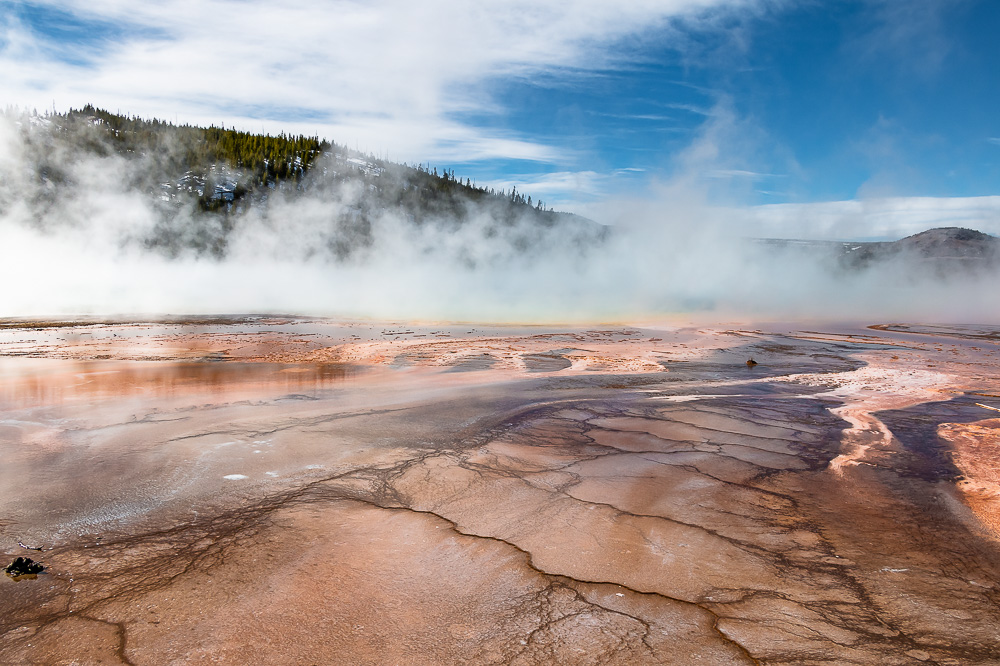
Photographing Grand Prismatic Spring
Photographing the Grand Prismatic Spring is a sure way to keep the memories alive when you, like the first explorers, start doubting the brightness of the colorful rings. Photography at the Grand Prismatic Spring, however, often goes against accepted rules. With that said, mornings when fewer people visit the basin might not be the best time to capture the saturated colors.
You should always plan to return to the spring and shoot its vibrant shades at different times of the day. But if you have only one chance, follow these tips to improve your Grand Prismatic Spring’s photography.
Photographing Up-Close
Don’t underestimate the power of a close-up shot. While the iconic images of the Grand Prismatic Spring from above tempt you to hit the trail right away, visit the boardwalk to spend some time shooting the vibrant colors from the near distance. Choose the right angle and find the best perspectives of one of the most photographed features in Yellowstone National Park.
The boardwalk that allows you to capture your masterpieces up-close is usually busy in summer. Thus, visit the Grand Prismatic Spring in early spring or late fall and photograph the bright rainbow colors with significantly less distractions. On the other hand, heavy steam frequently covered the whole spring at this time of the year. Don’t rush. Wait for the wind to change its course and clear the view before pressing the shutter button again.
Photographing Grand Prismatic Spring From Above
Grand Prismatic Spring Overlook is the highlight of any visit to the basin. Photographers are especially fond of this elevated area. Overlooking the Midway Geyser Basin, the place offers a vantage point of the largest hot spring in the U.S.
The majority of the professional photographers and amateurs visit the overlook in attempt to create their own masterpieces of the Grand Prismatic Spring. You can surely join their ranks. However, be ready to shed some sweat while hiking uphill before photographing the spring in its full glory. Additionally, you might want to bring a wide angle lens along for those amazing shots.
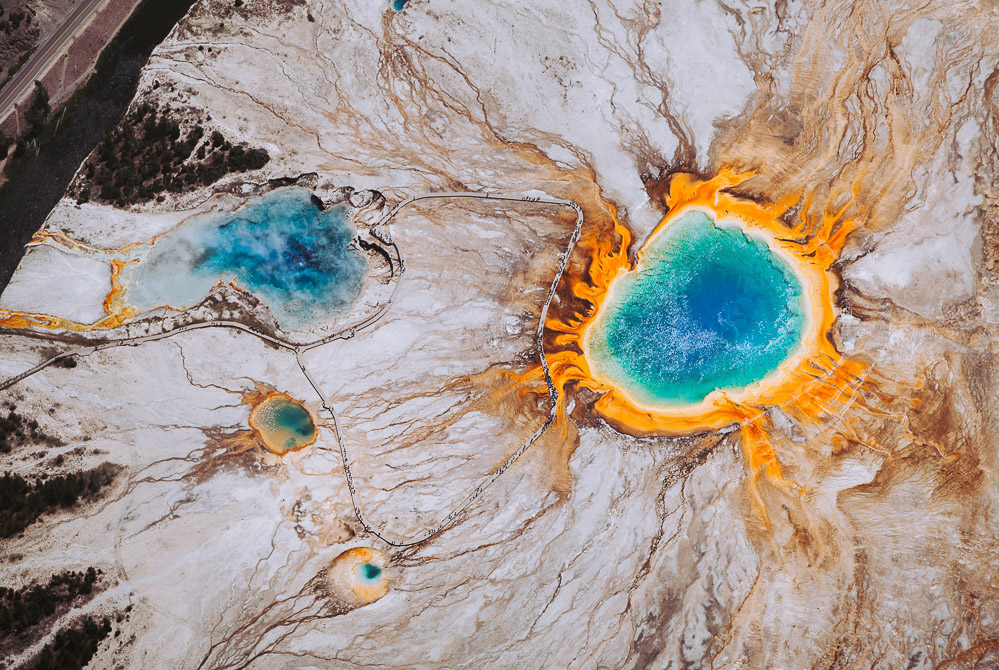
The Best Time for Photography
The colors are brighter at around noon, allowing for more saturated images. On the other hand, visit the Grand Prismatic Spring at this time, and you run into a problem of sharing the place with too many tourists.
Summer also has its positive and negative sides for landscape photography. Although the busiest time to visit the Grand Prismatic Spring (negative), it helps saturate the rainbow colors of the bacterial mats around the hydrothermal features (positive).
To put it short, photography at the Grand Prismatic Spring is a constant trade-off between the optimal time for color saturation and the time when fewer people visit the place.
Drone Photography at Grand Prismatic Spring
Flying drones into the Grand Prismatic Spring is illegal. The area is ecologically fragile and needs protections from any external disturbances, especially accidental drops of any items, including drones, into it.
The last known attempt of using a drone for photographing the Grand Prismatic Spring from aerial perspective happened in 2014. A Dutch tourist, Theodorus Van Vliet, flew his drone into the Grand Prismatic Spring. The devise got crushed and was never found. The incident didn’t seem to have any negative effects on the Grand Prismatic Spring. Neither did it raise any environmental discussions and concerns. Meanwhile, a U.S. federal judge ordered the unfortunate visitor to pay $1,000 in fines and $2,200 in restitution fees.
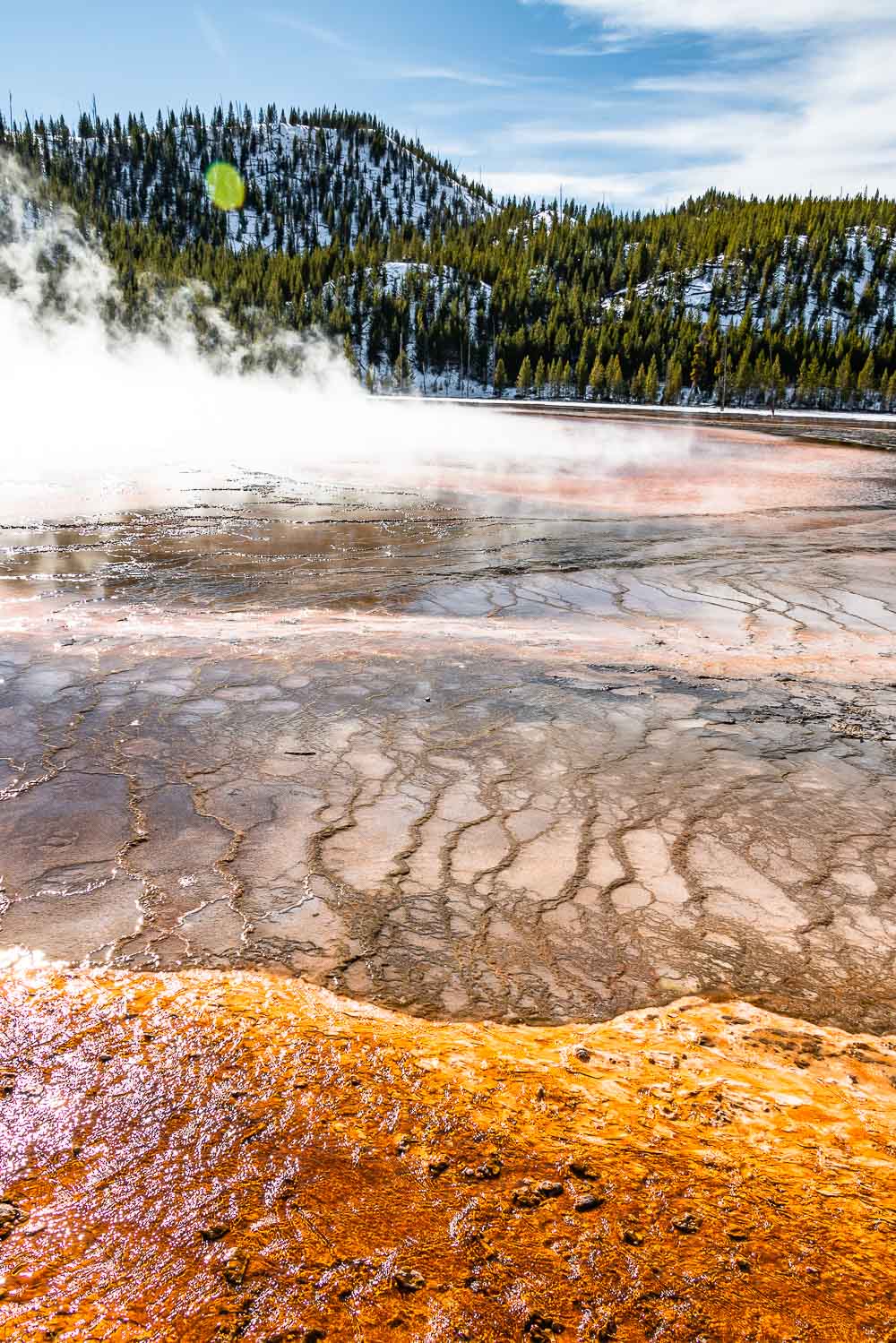
Safety when Visiting Grand Prismatic Spring
- Stay only on the boardwalk. It is illegal and dangerous to walk off the designated area in the Midway Geyser Basin. The boardwalk fulfills two function. It protects the visitors from the boiling water and deadly surface of the Grand Prismatic Spring. Simultaneously, it safeguards the fragile natural environment from any external devastating damages. So, do your part and keep the nature safe while avoiding any mishaps, including accidental skin burns, when visiting the Grand Prismatic Spring.
- The Midway Geyser Spring is famous for its strong winds. Thus, offer support to the elderly visitors as well as always hold hands of the younger ones when walking on the boardwalk near the hydrothermal features.
- It’s rare to see wildlife near the Grand Prismatic Spring on a busy day. If it happens, though, keep a safe distance. Yellowstone National Park recommends its visitors to not approach bison, elk, and other large animals closer than 25 yards. For bears and wolves, increase this distance to 100 yards.
- Dogs are not allowed near the Grand Prismatic Spring and for a reason. You simply can’t tame the bewildered animals in such a strangely beautiful, but unfriendly environment.
- Swimming is prohibited in the Grand Prismatic Spring. The water is too hot, and the bacteria is too fragile to even try to attempt such a silly thing. Yet, you can swim in Yellowstone National Park, but only in a few designated areas. The Boiling River Swim Area and the Firehole River Swim Area are just a few places where you can test the warm water of the park without getting burnt. When swimming, though, you are on your own. No lifeguards will rush to your side if such necessary arises. Moreover, thermal water can contain organism that cause rashes and dangerous infections.
Interesting Facts About Grand Prismatic Spring
- At the depth of 160 feet, the Grand Prismatic Spring is deeper than a 10-story building.
- The spring is 360 feet long and 160 feet wide. It’s bigger than a football field.
- The Grand Prismatic Spring discharges 560 gallons of water per minute.
- The geothermal waters of this natural phenomenon can get as hot as 250 degrees Fahrenheit.
- The first record of the Grand Prismatic Spring dates back to 1839 when a group of trappers from the American Fur Company happened to visit it. The travelers described the spring as a “boiling lake”.
This concludes our guide to the Grand Prismatic Spring. I hope it answers all your questions and helps plan your own trip.
TIP: If you’re looking for more travel tips and information about Yellowstone National Park, please check out these guides.
- 10 Things You Must See on Your First Visit to Yellowstone
- Where to Find the Best Historic Buildings in the American West
- Visit Upper Geyser Basin in Yellowstone: Guide, Features, Tips, and Map
If you found this post useful, don’t forget to pin it for later and share it with your friends.
